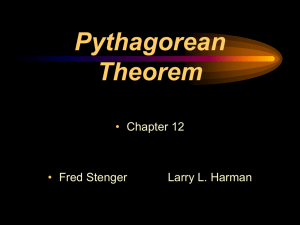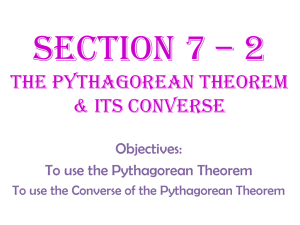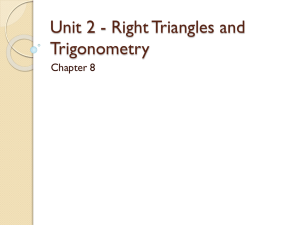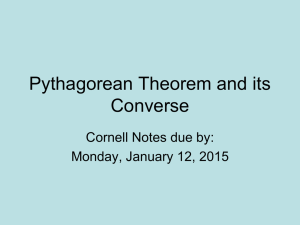Pythagorean Theorem Project
advertisement
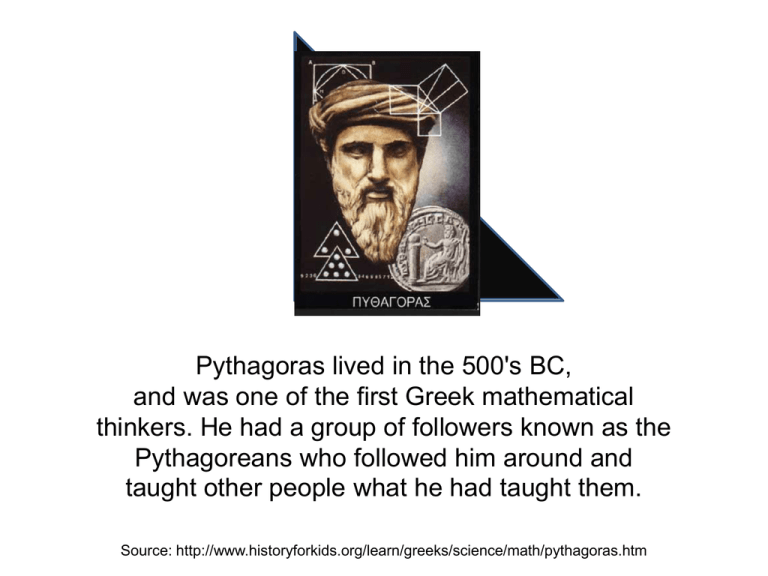
Pythagoras lived in the 500's BC, and was one of the first Greek mathematical thinkers. He had a group of followers known as the Pythagoreans who followed him around and taught other people what he had taught them. Source: http://www.historyforkids.org/learn/greeks/science/math/pythagoras.htm Pythagoreans were interested in philosophy, but especially in music and mathematics, two ways of making order out of chaos. Music is noise that makes sense, and mathematics is rules for how the world works. Source: http://www.historyforkids.org/learn/greeks/science/math/pythagoras.htm Pythagoras himself is best known for proving that the Pythagorean Theorem was true. Source: http://www.historyforkids.org/learn/greeks/science/math/pythagoras.htm The Pythagorean Theorem says that in a right triangle, the sum of the squares of the two right-angle sides will always be the same as the square of the hypotenuse (the long side). A2 + B2 = C2. Source: http://www.historyforkids.org/learn/greeks/science/math/pythagoras.htm A Tale of Three Cities – The Pythagorean Theorem Step-by-Step Instructions 1. Using Google Maps, find three cities that form a right triangle. Left-click and hold the mouse to move the map to any location on the planet. Zoom in and out until the three cities fill the map window. 2. Print the map to a printer or print to a PDF creator program. Many of these programs are available for free. If you are using the PDF method, instead of saving the map as a PDF, use the PDF creator software to save the map as a JPEG (photo). Save it into a specific folder. Next, in that folder right-click on the map photo, choose copy and then open a new Presentation document where you will paste the map onto a slide. 3. On the printed map, use a straight edge to draw a right triangle between the three cities. If you are using the PDF/JPEG method, use your Presentation software to open and paste a right triangle on top of the JPEG map. You can edit the triangle using the Format Shape function (remove the fill, the thicken the line, change the line color, etc.) 4. On a separate slide, insert a Right Triangle, then add labels for the three sides and the three City Names. 5. On another slide, write out the definition for the Pythagorean Theorem (see example). 6. On the same slide, use a “Distance Finder” website to find the actual distance between the cities on side a. and the cities on side b. of the Right Triangle (see example). 7. Use the Pythagorean Theorem to solve for the distance of side c (see example). 8. On this same slide, give the name of side c. 9. Next, solve the following problem. Traveling at an average rate of 50 miles per hour, calculate how long it will take to make a round trip journey to all three cities, including an 8-hour sight-seeing tour in each city. Show this on a separate slide. 10. Using Custom Animation in Microsoft Powerpoint, create a presentation in which you move a vehicle around to each city on your map. Choose a vehicle using Clip Art or a photo. 11. As your vehicle reaches each city, stop and present 10 facts about that city (see list provided). Show these facts on a separate slide for each city. A Tale of Three Cities – The Pythagorean Theorem The first step is to go to Google Maps and use the Zoom tool to zoom in and out until you find three cities that form a right triangle. City 1 City 2 City 3 A Tale of Three Cities – The Pythagorean Theorem A Right Triangle placed on top of a JPEG photo of a Google Map. Students may print the Google map to a printer and use a ruler to draw a right triangle on the map or print the map to a PDF creator program and save it as a JPEG photo. If the PDF method is used, students can copy the map into the presentation software and then insert a right triangle on top of the map as shown here using the Insert > Basic Shapes command. A Tale of Three Cities – The Pythagorean Theorem City Name 1 Students must draw a right triangle in the presentation software with labels for the cities and the sides of the triangle. c a City Name 2 b City Name 3 A Tale of Three Cities – The Pythagorean Theorem San Angelo a Dallas Example c b Galveston A Tale of Three Cities – The Pythagorean Theorem The equation for the Pythagorean Theorem is _____________________ Use a Distance Finder website to find: Example 232 The distance between City 1 and City 2 (Side a.) = ___________ miles. 269 The distance between City 2 and City 3 (Side b.) = ___________ miles. Using the equation for the Pythagorean Theorem, solve for the distance between City 1 and City 3 (Side c.). 232 miles2 + 269 miles 2 = c2 c2 = c 53,824 + 72,361 = c2 126,185 = c 126,185 = c2 355 miles c = _______ 355 The distance between City 1 and City 3 = ____________ miles. Side c is called the _______________________ A Tale of Three Cities – The Pythagorean Theorem In our example, the total distance is 232 miles + 269 miles + 355 miles = 856 miles A nice little getaway. A Tale of Three Cities – The Pythagorean Theorem Solve this problem. You will make a round trip journey to all three cities traveling at an average rate of 50 miles per hour. Additionally, you will stay 8 hours in each city on sightseeing tours. How long will the trip take? _________ hours. If we know the distance (miles) and the rate (miles per hour), we can find the time (hours) based on the following formula: Distance = Rate x Time d=rxt 856 miles = 50 miles per hour x t 856 miles 50 miles per hr = 50 miles per hour x t 50 miles per hr t = 17 hours, then add 24 hours = 41 hours A Tale of Three Cities – The Pythagorean Theorem Using clip art or a photo, insert a vehicle onto your map. Move it around to all three cities using Custom Animation. Stop the animation after each leg of your trip, and go to the facts for that city. A Tale of Three Cities – The Pythagorean Theorem Find these 10 facts on each city. FACT SHEET City Name 1. State 2. Year Founded 3. Current Population 4. Longitude and Latitude 5. Weather Fact 6. Current Mayor 7. Form of Government 8. Largest Employer 9. Two Colleges 10. A fun activity that you would do if you were there. Click your mouse or hit the space bar to move the car along its trip. San Angelo 1. Texas 2. 1867 3. 88,439 4. 31°27′11″N / 100°27′9″W 5. San Angelo averages 251 days of sunshine a year 6. Alvin New 7. Council-manager 8. Shannon Medical Center 9. Angelo State University and Howard College 10. 10 miles of river frontage on the Concho River winding through downtown and beyond. Dallas 1. 2. 3. 4. 5. Texas 1841 1,279,910 32°47′0″N / 96°48′0″W Winters in Dallas are generally mild, with normal daytime highs ranging from 55 °F (13 °C) to 70 °F (21 °C) 6. Tom Leppert 7. Council-manager 8. American Airlines (22,077 employees) 9. Southern Methodist University (SMU) and Texas Woman’s University 10. Dallas Cowboys in the new Cowboys Stadium Galveston 1. Texas 2. The first permanent European settlements on the island were constructed around 1816 by the pirate Louis-Michel Aury 3. 57,466 4. 29°18′04″N / 94°47′51″W 5. In 1900, the island was struck by a devastating hurricane. It holds the record as the United States' deadliest natural disaster killing 6,000 to 8,000 people on the island 6. Lyda Ann Thomas 7. Council-manager 8. University of Texas Medical Brach at Galveston 9. Galveston College and Texas A&M University at Galveston 10. Mardi Gras, Moody Gardens Wow, that was a fun trip. The End. I hope you enjoyed this lesson.



